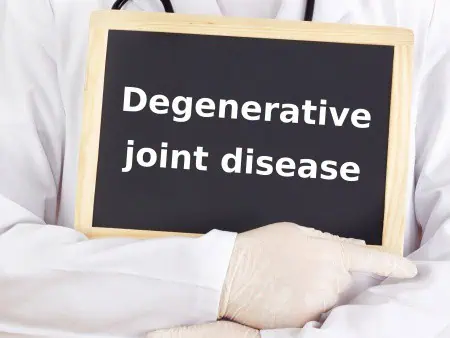Patients with degenerative joint disease may be unable to work because of their disease and its related complications. Patients who find themselves unable to work because of their degenerative joint disease may qualify for long-term disability (LTD) benefits. The insurance company will review their claim to see if they are eligible under the conditions of that plan.
What Is Degenerative Joint Disease?
Degenerative joint disease is also known as osteoarthritis and is the most common form of arthritis, affecting approximately 27 million people in America. Arthritis is the term used to describe inflammation of the joints, while osteoarthritis refers explicitly to the wearing down of the cartilage in joints.

Joints in the human body are protected by cartilage, a rubbery cushion that stretches and decreases friction in the joints as they move. Degenerative joint disease causes cartilage to loosen and deteriorate. As this occurs and progresses, tendons and ligaments stretch, and bones can rub together in severe cases. This may cause the joints to be swollen, painful, and stiff.
“Articular” means “relating to a joint or the joints.”
Polyarticular joint pain, or polyarthralgia, means pain that involves multiple joints. Polyarticular joint disorders may even affect different joints at different times. When multiple joints are affected, the following distinction can help differentiate among other disorders, particularly different types of arthritis:
- Oligoarticular: Involving less than or equal to four joints;
- Polyarticular: Involving more than four joints.
The Two Types of Degenerative Joint Disease
There are two types of this disease. The first is primary osteoarthritis, which can occur as part of aging—although it does not always do so for everyone. The other type is secondary osteoarthritis, which occurs due to having some other disease.
Primary Osteoarthritis
As we age, our joints suffer “wear and tear,” which is the cause of primary OA. It typically starts showing up in those between 55 and 60. Theoretically, we all experience cartilage breakdown as we age; however, some cases are more severe than others.
Secondary Osteoarthritis
Secondary OA occurs due to a specific trigger that exacerbates cartilage breakdown. Here are some of the most common causes/triggers for secondary OA:
- Trauma/Injury: Bone fractures increase an individual’s chance of developing OA and can cause the disease to arrive earlier than usual.
- Obesity: According to the Arthritis Foundation, each pound of extra body weight places three pounds of pressure on the knees and six pounds on the hips. Excess weight speeds up the “wear and tear” of joint cartilage.
- Inactivity: This is a chain reaction. Inactivity can cause obesity, which in turn weakens the muscles. Weaker muscles mean poorly aligned joints and an increased risk for OA.
- Genetics: Researchers have determined that OA runs in families, so specific family genes could also place you at risk.
- Inflammation: Diseases that increase inflammation can also affect the cartilage in the body. An example of such a disease is rheumatoid arthritis.
Symptoms of Joint Disease
The usual symptoms of the condition are continuous, stinging pain in the muscles around the affected area and stiffness in the joints that can hinder the ability to move since pain increases with pressure.
Articular sources of pain come from within the joint. Periarticular sources of pain come from structures surrounding the joint (e.g., tendons, ligaments, bursae, muscles).
Polyarticular pain caused by articular sources may be caused by one or more of the following:
- Inflammation (such as an infection, crystal-induced arthritis, systemic inflammatory disorders such as rheumatoid arthritis and psoriatic arthritis) and
- Mechanical or other noninflammatory disorders (such as osteoarthritis or hypermobility syndromes)
The synovium and joint capsule are the primary sources of pain within a joint. The synovial membrane is the main area affected by inflammation (synovitis). Pain that affects multiple joints but does not show evidence of inflammation may be due to increased joint laxity and excessive trauma, such as in benign hypermobility syndrome.
Polyarthritis may involve peripheral joints, axial joints (such as sacroiliac, apophyseal, disco vertebral, costovertebral), or both.
Most Commonly Affected Joints
Though degenerative joint disease can affect any joint in the body, the most common affected areas are the weight-bearing joints in the hips, knees, and spine. As the cartilage wears away and the joints lose their flexibility, the stress put upon them by standing or walking causes osteoarthritis pain.
This is a prevalent disease, believed to be hereditary, causing around 25% of all doctor visits and affecting anyone from age 20 up. Most people over the age of 60 have degenerative joint disease with varying degrees of pain. For some, it can strike so severely that it prohibits normal movement.
Working with a Long-Term Disability Attorney
Working with an experienced disability attorney will give you the best chance of getting the benefits you deserve for your degenerative joint disease. Even if you have been denied benefits, that does not mean your fight is over. Many people are denied benefits the first time they apply. You have the right to file an appeal and try to get more information that may help your case. Getting expert help is often the difference between being denied and being approved for benefits.
While the process can be daunting, your experienced disability attorney will be able to guide you through the process. They do not get paid until you win your case. You can seek help without worrying about upfront costs or unexpected bills.
The Ortiz Law Firm has successfully represented people in disability cases across the United States. If you would like to talk to an experienced disability lawyer about your degenerative joint disease and its impact on your ability to work, call us at (888) 321-8131. We would be happy to evaluate your case and discuss how to help you through the appeal process.

